Introduction
Looking for information on the internet has become increasingly popular because of its advantage in data accessibility over conventional methods such as books stored in a library (Butler 2004). Google Trends (https://trends.google.com), a website created by the Google company, analyzes the popularity of search terms (i.e., keywords) used in Google Search. Researchers have shown that such data may provide practical information for understanding trends in search terms (Nuti et al. 2014; Jun et al. 2018). The purpose of this EDIS article is to briefly discuss the trends of search terms, with an emphasis on Florida’s major crops, that may provide insight into the general public’s interest. We examined Google Trends datasets consisting of several search terms related to Florida’s top commodity crops; these search terms were used as a proxy for public interest in the world and the United States over the last six years. In addition, we explored the top related queries to a given search term. With increased knowledge about the interest and perception of the general public regarding Florida crops, Florida’s agricultural industries can better respond to the needs and concerns of consumers. The target audience of this publication includes those involved in agriculture as well as the general public.
Trend Analysis
Trends in the world and the US were obtained by using Google Trends for each month from January 2016 to February 2022 (a total of 73 months; data accessed on Mar. 1, 2022). The searches included three major commodity crops in Florida: orange, strawberry, and tomato (Florida Department of Agriculture and Consumer Services 2022). Additional terms such as “price” and “flavor” were searched to capture a comparative dataset reflecting public interest. Google Trends normalizes the search volume for a given search term and scales it on a range of 0 to 100 along the vertical axis “Interest over time” in Google Trends’ graphical output. Mann-Kendall and t-test statistics were used to determine whether a significant change (increase or decrease at p < 0.05) in search volume occurred and whether the trends for two search terms were significantly different (p < 0.05), respectively.
Current Search Trends for Orange, Strawberry, and Tomato
Figure 1 shows the trends for the five search terms, including three commodity crops, i.e., orange, strawberry, and tomato, and the top two food crops, i.e., rice and wheat (Food and Agriculture Organization 2022), in the world and the US. The three terms “strawberry,” “tomato,” and “rice” show upward trends in both categories, i.e., the world and the US, with a food category as the top related query (e.g., Google Trends users searching for “tomato” also searched for “tomato sauce”). Interestingly, the decrease in “orange” in the world was significant over 6 years, while this trend was not significant in the US. None of the top three related queries to “orange” were food-related.
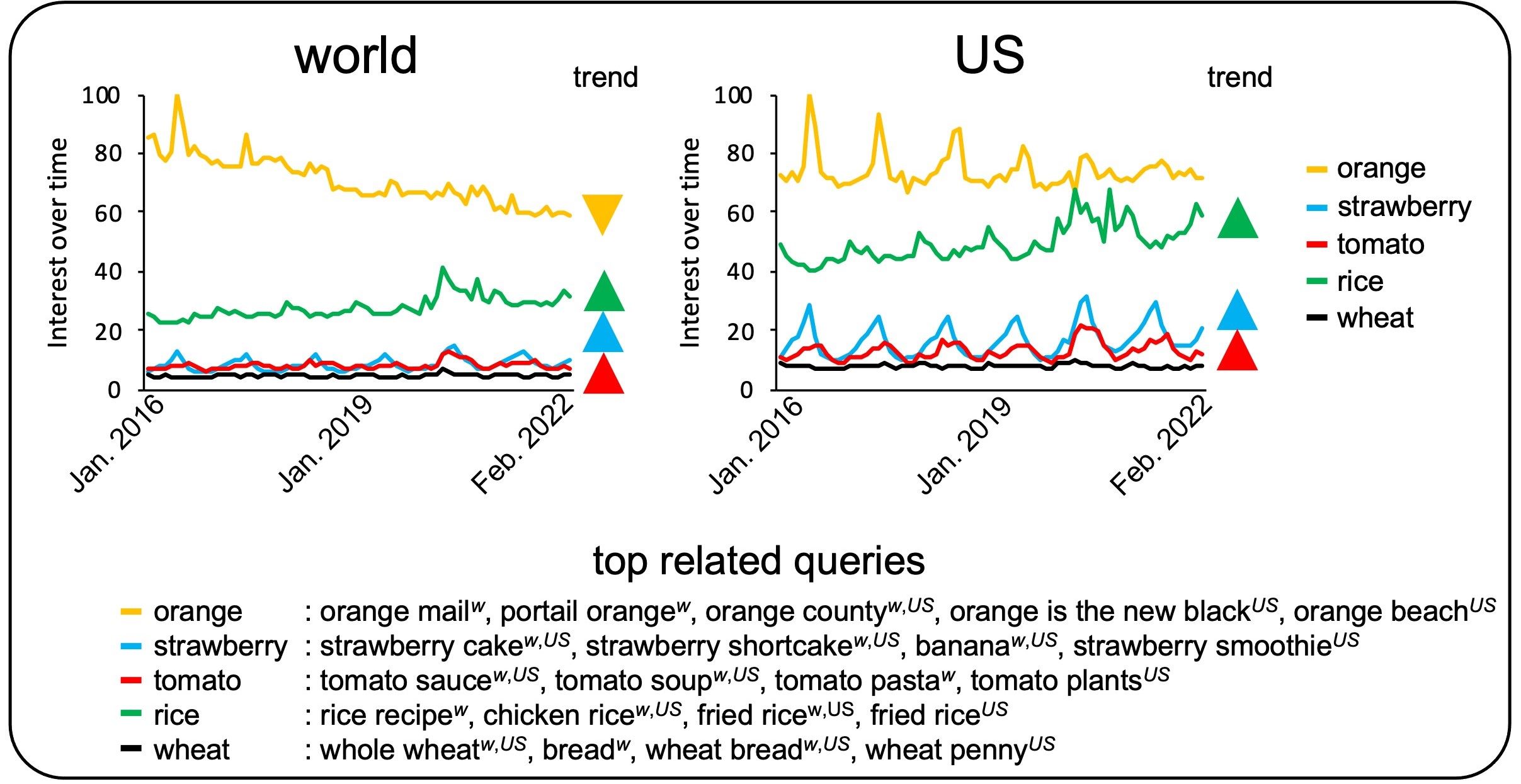
Figure 2 shows the trends for the five search terms with “price” included. Overall, the trends increased over the time interval analyzed. The search interest in “rice price” was higher than that in “orange price” in the world, while the opposite was observed in the US. In the US, the search interest in “orange price” was higher than that in “strawberry price” and “tomato price.”
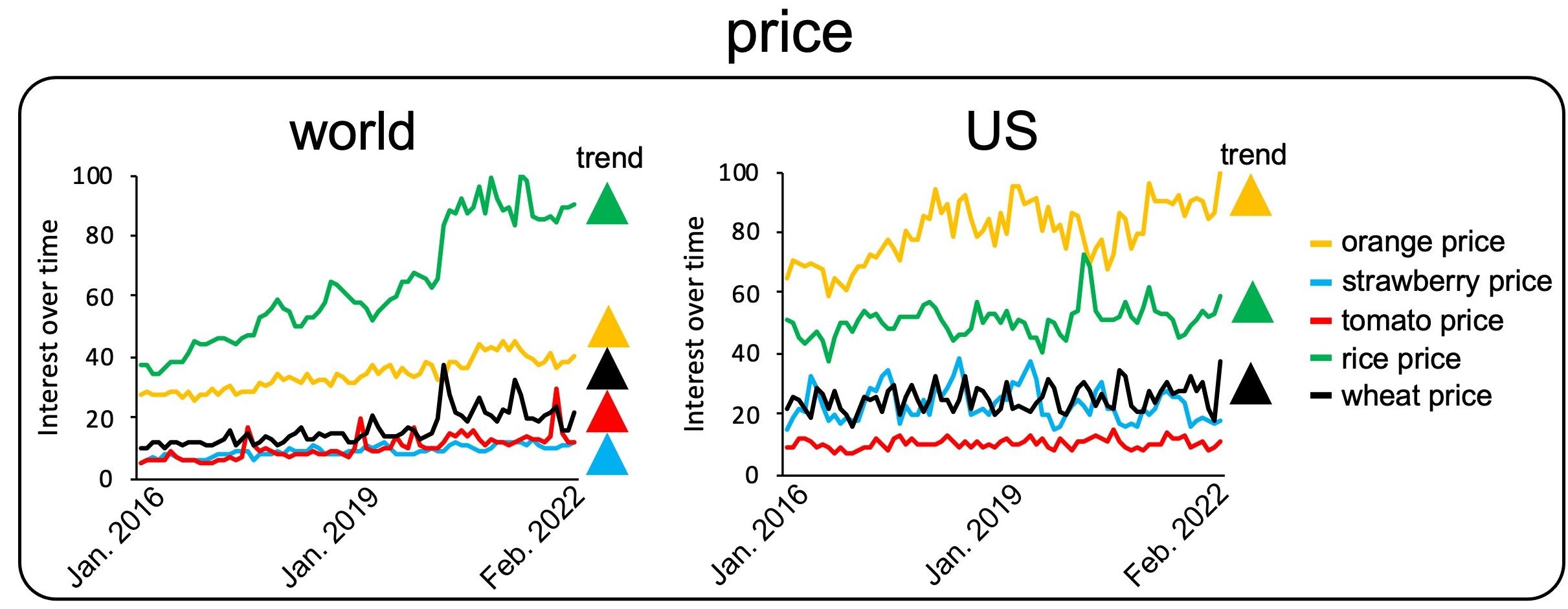
In the examination of the search trends for “flavor,” all five search terms, including “banana flavor” and “lettuce flavor," showed upward trends (Figure 3). It is interesting to note that both “orange flavor” and “strawberry flavor” searches were statistically significantly higher than searches of “tomato flavor,” at least for the six years examined. Overall, the top related queries found in the world overlapped with those searched by the US, except for “lettuce flavor.”
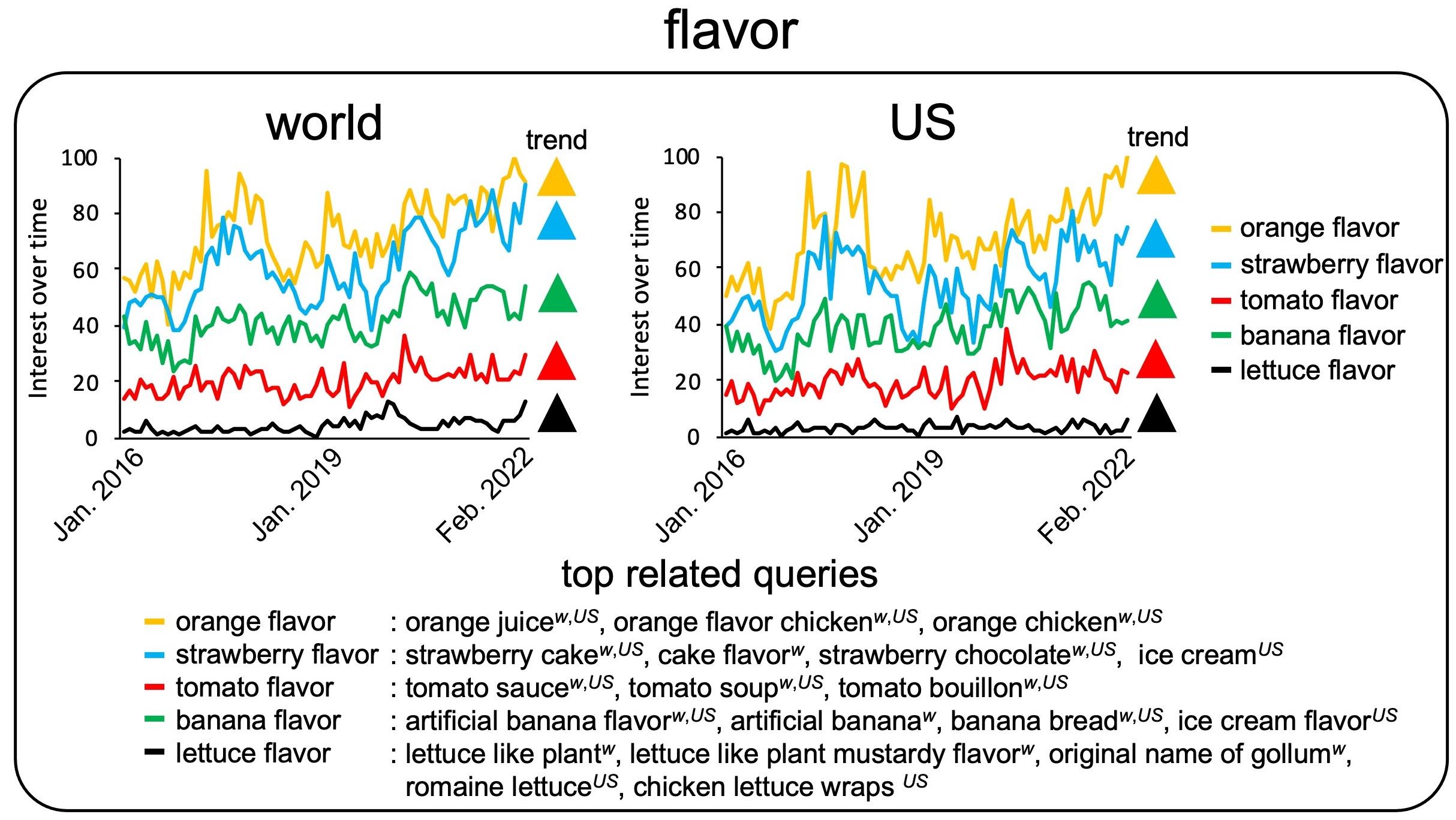
Genetically modified organisms (GMOs) are still one of the most controversial issues in food from the ethical, socioeconomic, and regulatory perspectives. The first GMO produced through genetic engineering in the US was a tomato, and most corn, the most commonly grown crop in the US, is a GMO (US Food and Drug Administration 2022). Surprisingly, the search interest in “GMO food,” “GMO corn,” and “GMO tomato” showed significant downward trends in both the world and the US over the last six years (Figure 4).
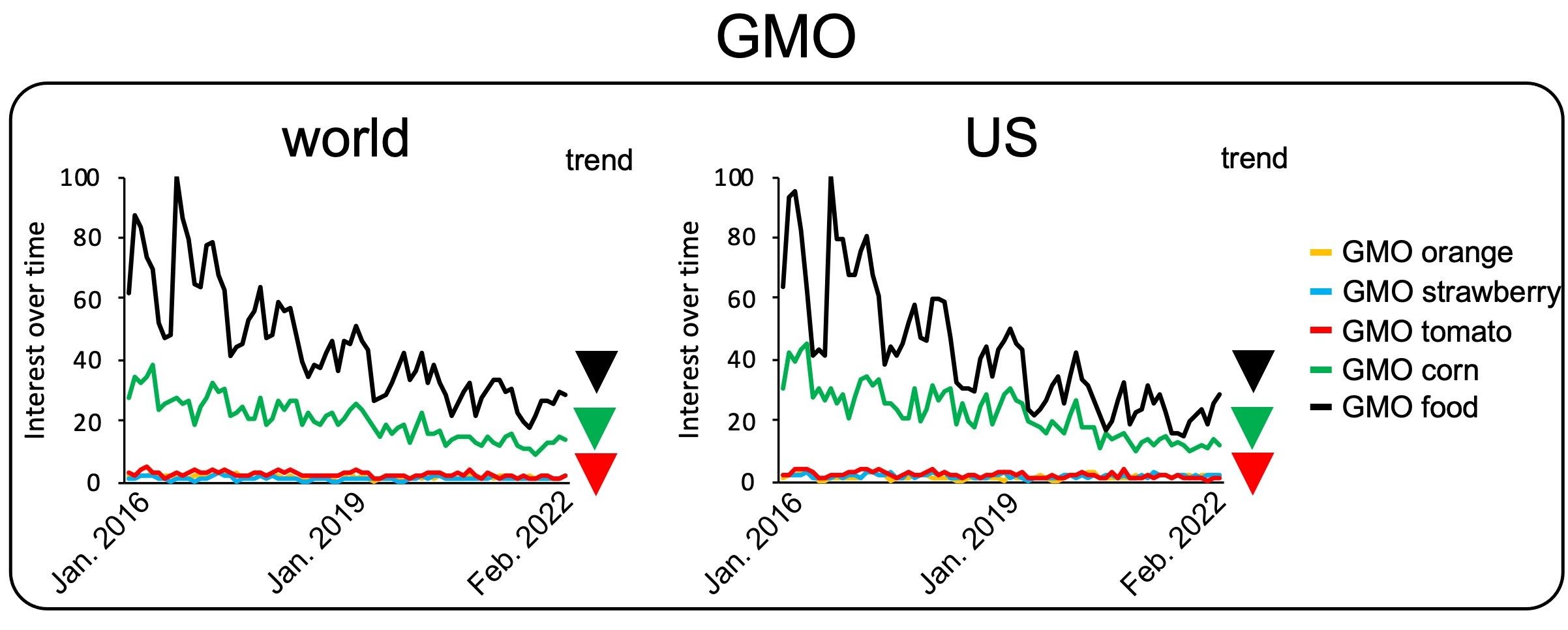
CRISPR-Cas9 technology, simply called CRISPR, is a more contemporary biological technology that can be used to edit the DNA sequence of a gene, similar to the genetic modification in GMOs (Lee 2018). However, the United States Department of Agriculture does not currently subject CRISPR-driven plants to the same rules as traditional GMOs (Hoffman 2021; Animal and Plant Health Inspection Service 2022). We further compared the search interest in “GMO” to the search interest in “CRISPR” (Figure 5). The trend for “CRISPR” was clearly the opposite of that for “GMO” in both categories, i.e., the world and the US. If this trend continues, one could speculate that the search volume for “CRISPR” might soon exceed that for “GMO.” Furthermore, the top related queries to “CRISPR” were quite unlike those to “GMO” such as food(s).
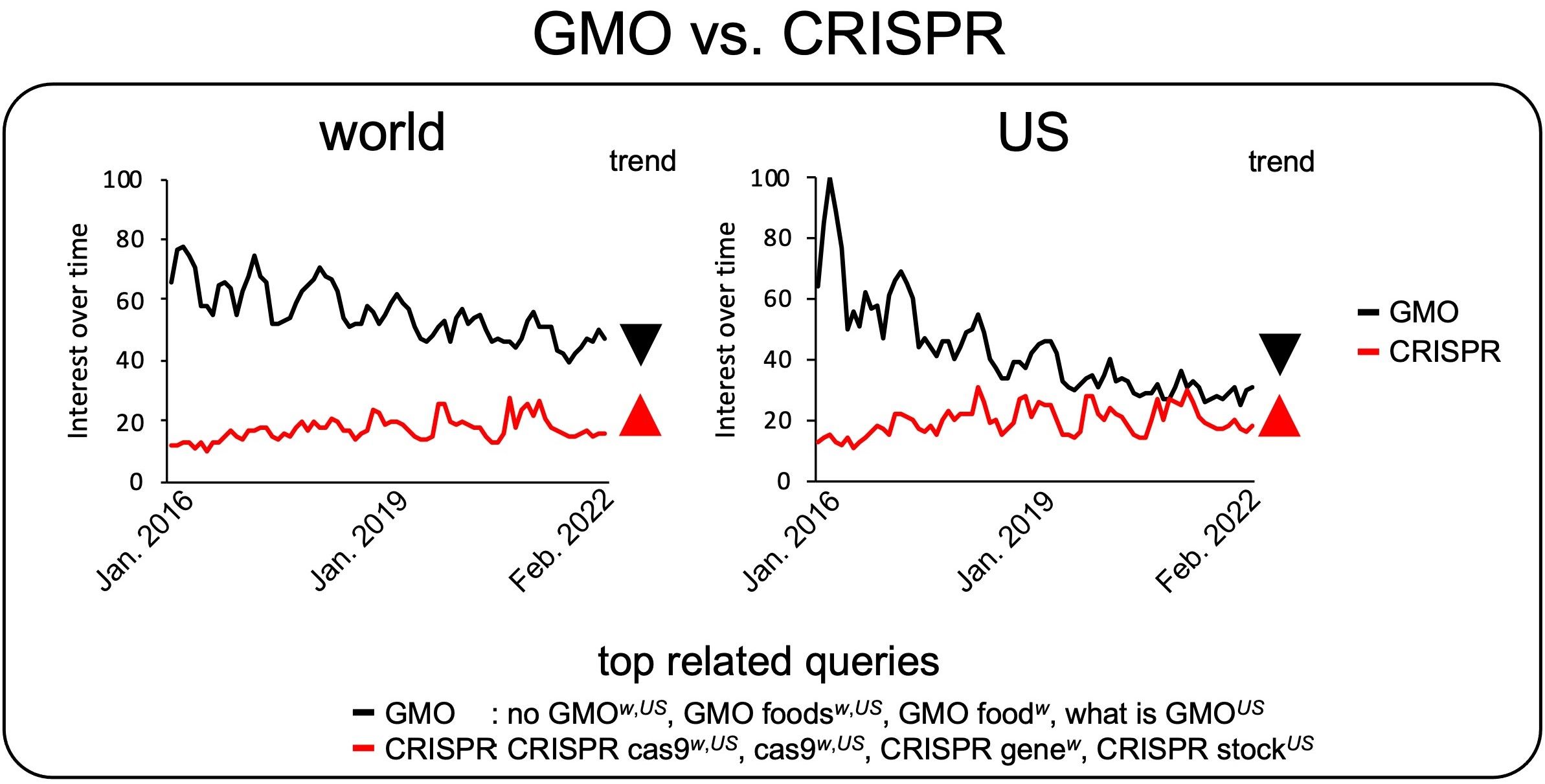
Conclusions
Several trends were apparent, such as the higher search interest in orange and strawberry flavor compared to the search interest in tomato flavor, as well as decreasing search interest in GMOs over time. These can be further studied using hypothesis-driven experiments tightly coupled with social science. Continued examination of the trends for diverse search terms as well as independent datasets such as targeted surveys could provide increased insight into the general public’s interest, which might link to their behavior (e.g., changes in consumer’s behavior). Such examination can be expanded to predicting public interest.
References
Animal and Plant Health Inspection Service. 24 Feb. 2022. https://www.aphis.usda.gov/aphis/home
Butler, D. 2004. “Science Searches Shift Up a Gear as Google Starts Scholar Engine.” Nature 432:423.
Florida Department of Agriculture and Consumer Services. 24 Feb. 2022. https://www.fdacs.gov
Food and Agriculture Organization. 24 Feb. 2022. https://www.fao.org
Hoffman, N. E. 2021. “Revisions to USDA Biotechnology Regulations: The SECURE Rule.” Proc. Natl. Acad. Sci. U.S.A. 118 (22): e2004841118.
Jun, S.-P., H. S. Yoo, and S. Choi. 2018. “Ten Years of Research Change Using Google Trends: From the Perspective of Big Data Utilizations and Applications.” Technol. Forecast. Soc. Change. 130:69–87.
Lee, T. G. 2018. “CRISPR: A Technical Breakthrough for Tomato Research: HS1314, 2/2018.” EDIS 2018 (1). https://doi.org/10.32473/edis-hs1314-2018
Nuti, S. V., B. Wayda, I. Ranasinghe, S. Wang, R. P. Dreyer, S. I. Chen, and K. Murugiah. 2014. “The Use of Google Trends in Health Care Research: A Systematic Review.” PLoS One 9 (10): e109583.
United States Food and Drug Administration. 24 Feb. 2022. https://www.fda.gov